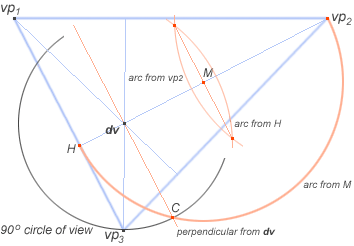Now we insert the 90° circle of view.
This requires you to find the midpoint of any of the three auxiliary horizon lines, draw a circle of Thales across it, and extend a perpendicular from the auxiliary horizon line at dv. The intersection of this perpendicular with the circle of Thales defines the radius of the circle of view.

Locating Measure Points.
Six measure pointsare required if they are marked along the horizon lines.
Only three are needed if you mark these on the auxiliary horizon lines.
To find them construct finish perpendiculars on each auxiliary horizon line, from dv to the circle of view: the intersection with the circle of view defines three new points, c1, c2 and c3. Draw arcs from each of these c points back to the auxiliary horizon line, using the vanishing point for the auxiliary horizon line as the center of the arc.

Carefully make seven measurements on this drawing to rescale it to full size:
(1) the longest distance between any two vanishing points (vp3 - vp2)
(2) the distance from one of these vanishing points to the intersection with the auxiliary horizon line (vp3 to h)
(3) the length of this auxiliary horizon line (h to vp1)
(4) the length to the direction of view (h to dv)
(5) the distance from dv to each of the three measure points mp1,mp2,mp3.
Divide the radius of the circle of view you want in the full sized drawing (say, 160cm) by the radius of the circle of view in your perspective sketch:
This gives you the full scale perspective space. Your perspective work surface needs to be at least as long as the longest horizon line and as wide as the 90° circle of view.
In the example drawing, assuming a 3m circle of view, this would be roughly 5m by 3m.
On a surface large enough to accommodate these distances (a very large table, or a clean hardwood or linoleum floor, or a clean, flat patio, garage floor or driveway), measure out the longest horizon line (in the figure, vp2 to vp1), and the auxiliary horizon line to vp3. Connect the three vanishing points to define the horizon line triangle. Measure the distance from the horizon line to dv, and draw the remaining two auxiliary horizon lines from the vanishing points through dv. Finally, mark the three mp's on each auxiliary horizon line, measured from dv.
 ශිල්ප 64
ශිල්ප 64